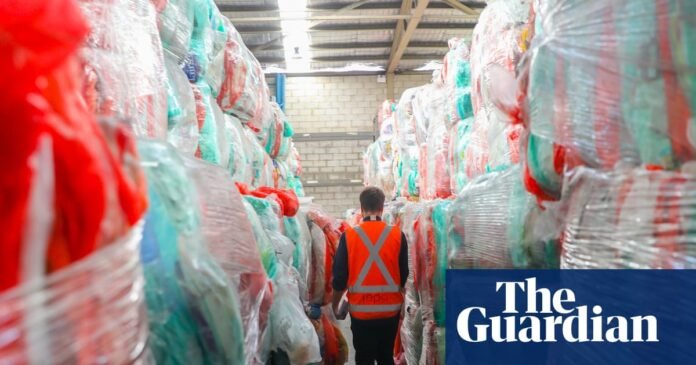Australia’s Soft Plastics Crisis: Two Years After REDcycle’s Collapse, Landfill Remains the Primary Destination
Australia is still grappling with the soft plastics crisis, with 94% of soft plastics heading to landfill two years after the collapse of REDcycle, a pioneering soft plastics recycling program. Despite the restart of collection at supermarkets and the clearance of 42 warehouses, experts stress that the packaging industry must take responsibility for the mess, with voluntary approaches having failed to address the issue. The onus is on plastic manufacturers to invest in facilities to take back their own material, as the lack of incentives or mandates for products made from recycled content hinders the development of a circular economy.
The soft plastics crisis in Australia is a complex issue that involves various stakeholders, including consumers, manufacturers, and governments. Two years ago, REDcycle, a soft plastics recycling program, collapsed, leaving a massive amount of soft plastics without a recycling solution. Since then, supermarkets have restarted collection, and 42 warehouses of plastics have been cleared. However, the problem persists, with 94% of soft plastics still heading to landfill. The main challenge is the lack of soft plastic recycling capacity in Australia, which cannot support full, nationwide collections. According to the Soft Plastics Taskforce, there is simply not enough recycling capacity to process the vast quantities of soft plastics produced in the country.
Current State of Soft Plastics Recycling in Australia
The collection of soft plastics has resumed at selected supermarkets, including Woolworths, Coles, and Aldi stores in New South Wales and Victoria. However, the taskforce members are being cautious not to collect more than can be processed, given the limited recycling capacity. Currently, only about 6% of used and discarded soft plastics are being recycled, while the rest ends up in landfill. The national packaging targets set by governments in 2018 aim for 70% of plastic packaging to be recycled by 2025, but the country is far from achieving this goal.
Challenges in Recycling Soft Plastics
Soft plastics are defined by their ability to be scrunched into a ball, unlike rigid plastics, which are molded to hold their shape. The main challenges in recycling soft plastics include:
* The vast quantities produced, with 538,000 tonnes of plastic bags, food wrappers, bubble wrap, and other flexible plastic waste generated in Australia each year.
* Design packaging that is too complex to recover, with many products comprising different types of plastic and contaminated by inks used for advertising or food residues.
* The lack of demand from packaging companies and other consumers for Australian-made recycled plastic, which makes it difficult for recyclers to sell their products.
According to Gayle Sloan, the chief executive of the Waste Management and Resource Recovery Association of Australia, “We’ve got to stop putting it on consumers to solve the problem. We need to have clear design standards, and they need to be enforceable, and we actually need those who make this to be held accountable and invest in facilities to take it back.”
Solutions to the Soft Plastics Crisis
Experts agree that the solutions to the soft plastics crisis are similar to other material and waste challenges. These include:
* Designing plastic packaging so it can be more easily recycled, while retaining its function, such as keeping food fresh.
* Developing recycling infrastructure capable of turning large volumes of soft plastic waste into a usable material.
* Reinforcing demand for the recovered material, which can be achieved through incentives or mandates for products made from recycled content.
Jennifer Macklin, a researcher at Monash University’s Sustainable Development Institute, notes that “We’re quite good at collecting and reprocessing, but not very good at buying it to turn it into new things.” She stresses that producers and importers of plastics should be responsible for the material’s entire lifecycle.
Government Response and Future Directions
The federal government has consulted on options for reforming plastic packaging, with 80% of stakeholders supporting regulation and 65% supporting an extended responsibility scheme that would make plastics producers responsible for the entire product lifecycle. The government is working with industry and state and territory governments to deliver fit-for-purpose packaging regulations as part of Australia’s transition to a circular economy. However, experts argue that voluntary approaches have failed, and clear design standards and enforceable regulations are needed to address the issue.
In conclusion, the soft plastics crisis in Australia is a complex issue that requires a comprehensive approach to address. The packaging industry must take responsibility for the mess, and the government must implement effective regulations to ensure that soft plastics are recycled and not sent to landfill. By designing packaging for recyclability, developing recycling infrastructure, and reinforcing demand for recycled products, Australia can transition to a circular economy and reduce the environmental impact of soft plastics.
Keywords: soft plastics, recycling, landfill, REDcycle, packaging industry, circular economy, waste management, recycling capacity, design for recyclability, extended responsibility scheme.
Hashtags: #SoftPlastics #Recycling #Sustainability #WasteManagement #CircularEconomy #Australia #PackagingIndustry #REDcycle #RecyclingCrisis #EnvironmentalImpact #SustainableDevelopment #WasteReduction #RecyclablePackaging #ClosedLoopRecycling #RecyclingInfrastructure #RecycledProducts #PlasticWaste #PlasticPollution.
Source link
